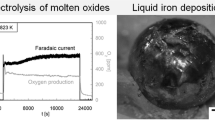Abstract
Oxidation, in oxygen gas at atmospheric pressure, of copper-manganese alloys (Mn content less than 40 at.%) has been investigated between 600 and 850° C. The reaction kinetics, determined by thermogravimetry, follow a parabolic law for alloys having a low manganese content (less than 10 at.% Mn) but are more complex for higher concentrations, particularly in the first stages of the oxidation process. Whereas in the early stages of oxidation the kinetics are controlled by surface reactions which accompany the formation of the different oxide layers, they are later controlled by the diffusion of a mobile species when the parabolic law is followed. In this condition an apparent activation energy may be determined from the rate constants. These energies are of the order of 120–140 kJ mol−1, comparable with that for oxidation of pure copper (134 kj mol−1), indicating a similar oxidation mechanism.
The oxide layers formed were identified by cross-checking results of X-ray diffraction, electron microprobe analysis, and from glow discharge spectrometry. External layers of CuO and Cu2O formed on alloys of lower manganese concentration, evolving towards one or several mixed copper-manganese oxide layers with increasing manganese content. Under the external layers, which were weakly adherent to the sample, an internal-oxidation layer formed, which was adherent and consisted of precipitates of Mn3O4/MnO dispersed in the copper lattice. For alloys richer in manganese (36 at. % Mn) and at temperatures above 850°C (20 at.% Mn), the internal-oxidation layer evolved into two zones: MnO particles beneath a zone of Mn3U4 particles.
Similar content being viewed by others
References
F. A. Shunk,Constitution of Binary Alloys, 2nd Suppl. (McGraw-Hill Book Co., New York, 1969).
O. Morel, L. Gautier, R. von Arnim, D. Ansel, and J. Debuigne,Scripta Met. 22, 339 (1988).
J. L. Aubin, D. Ansel, and J. Debuigne,J. Less-Common Met. 113, 269 (1985).
F. N. Rhines,Trans. A.I.M.E. 137, 246 (1940).
F. N. Rhines, W. A. Johnson, and W. A. Anderson,Trans. A.I.M.E. 147. 205 (1942).
D. H. Howling,Phys. Rev. Lett. 17, 253 (1966).
D. H. Howling,Phys. Stat. Sol. 18, 579 (1966).
P. K. Panda, A. K. Lahiri, and T. Banerjee,Corros. Nace 28(2), 55 (1972).
C. Wagner,Z. Electrochem. 63, 772 (1959).
J. W. Liu, Thèse Doctoral (Université Paris VI, 1990).
J. Romanski,Corros. Sci. 8, 67 (1968).
J. Romanski,Corros. Sci. 8, 89 (1968).
S. Mrowec and A. Stoklosa,Oxid. Met. 3(3) (1971).
P. Villars and L. D. Calvert,Pearson's Handbook of Crystallographic Data for Intermetallic Phases, Vol. 1,2,3 (ASM, 1985).
M. Beley, L. Padel, and J. C. Bernier,Ann. Chim. Fr:3, 429 (1978).
F. J. J. van Lo, J. A. van Beek, G. F. Bastin, and R. Metselaar, inDiffusion in Solids: Recent Developments, M. A. Dagananda and G. E. Murch, eds. (T.M.S., 1985), p. 231.
Author information
Authors and Affiliations
Rights and permissions
About this article
Cite this article
Ansel, D., Liu, J.W., Bohn, M. et al. Oxidation of copper-manganese alloys under pure oxygen. Oxid Met 39, 31–54 (1993). https://doi.org/10.1007/BF00666608
Received:
Revised:
Issue Date:
DOI: https://doi.org/10.1007/BF00666608




